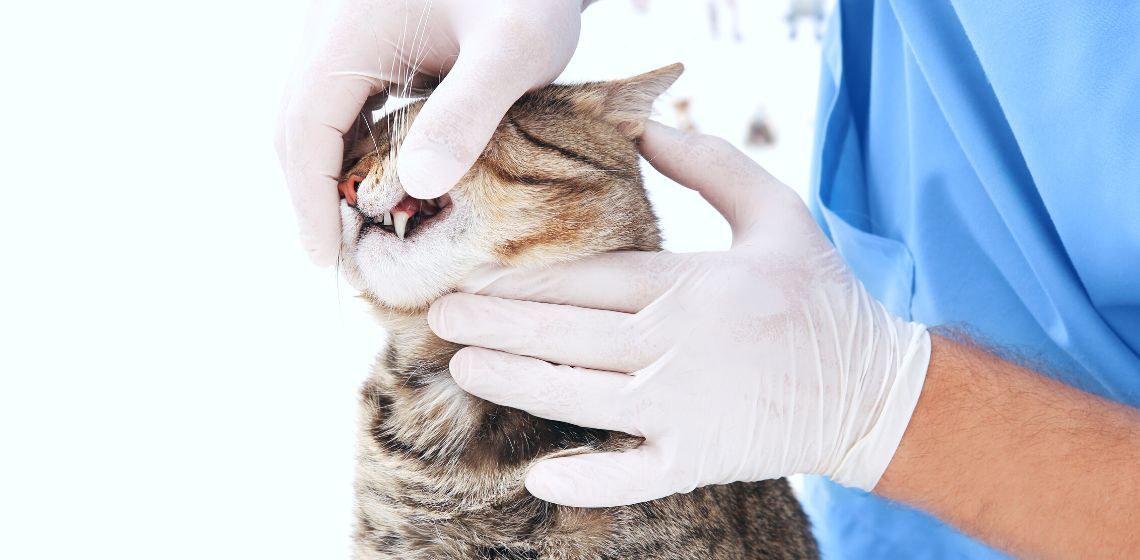Table of Contents
What is Stomatitis?
Stomatitis, or feline chronic gingivostomatitis, refers to a condition in which the structures within the oral cavity experience extreme inflammation. Inflammation can impact the gums, oropharyngeal region, and even the tongue.
What Causes Stomatitis?
The exact cause of stomatitis in cats is not completely understood. Inflammation of the mouth can occur for several reasons. Some patients may experience stomatitis secondary to viral infections, or potential trauma like electrocution or irritants. Most commonly, stomatitis in felines is thought to be caused by a dramatic immune response to bacteria found within the oral cavity.
As bacteria accumulate and plaque forms on teeth, gingivitis (defined as inflammation of the gingiva, and a sign of periodontal disease) develops. In cats who suffer from stomatitis, the inflammatory response to a small number of bacteria becomes extensive. Cats suffering from stomatitis have essentially become allergic to their own mouths. This article will focus on chronic feline gingivostomatitis occurring secondary to an exaggerated immune response to bacteria found in plaque.
Symptoms of Stomatitis in Cats
Cats suffering from stomatitis may show a variety of signs including:
- Halitosis (bad breath)
- Hypersalivation/drooling
- Weight loss
- Poor coat quality
- Decreased appetite
- Vocalization when eating
- Dropping food from their mouth
- Local lymph node enlargement
Diagnosing Stomatitis in Cats
Fortunately, diagnosing stomatitis can be done simply with a comprehensive physical examination. The veterinarian evaluating your cat or kitten will evaluate the patient’s oral cavity by lifting the lips to better evaluate the gingiva/teeth and by opening the mouth to better see the tongue and oropharyngeal area.
Bright red, sometimes swollen, tissues can be easily identifiable. Gingival tissue may bleed if touched, and there may be evidence of resorptive lesions on the crown of the tooth.
Oftentimes minimal plaque will be noted. The lack of severe plaque/tartar accumulation coupled with obvious inflammation can be suggestive of stomatitis.
Evaluation of a cat’s mouth who is suffering from stomatitis may be difficult as it is very painful. Sedation may be necessary.
Lab Work
Routine blood work may reveal elevated white blood cells (specifically elevated eosinophils, a type of white blood cells that often become elevated in patients combating allergies). A particular protein called Globulin may also be elevated.
Patients with stomatitis should be screened for Feline Immunodeficiency Virus and Feline Leukemia. Although screening for these viruses is recommended, there is not a strong correlation between FELV and FIV and the development of stomatitis.
Treatment of Feline Stomatitis
Unfortunately, feline stomatitis can be difficult to treat and often requires surgical intervention. Although from the outside, your pet may appear healthy, it is important to remember that the level of inflammation occurring within the oral cavity is painful, and needs to be addressed.
In some situations, medical management may be pursued. Anti-inflammatories (steroids or NSAIDS) may be temporarily beneficial in reducing oral inflammation. However, this is short-lived in many cats, and mouth pain will quickly return unless the underlying cause is addressed.
Antibiotics can also be used to reduce bacterial pathogens in the mouth. This also only brings temporary improvement.
General anesthesia may be pursued to perform a dental cleaning to remove plaque. Patients who receive this type of intervention will need to be closely monitored. If oral inflammation resolves, but resurfaces within 6 months or so, extractions will likely be necessary.
In cases of significant feline stomatitis, partial or full mouth teeth extractions may be necessary. This can be done by general practitioners, or you may be referred to a veterinary dentist. The vet performing this surgery will evaluate each individual tooth through probing and dental radiographs. Problematic teeth will surgically be removed, with the goal being less surface area will be available for plaque to form, hence lessening the inflammation within the mouth.
Some patients may not be cured with dental extractions or may experience occasional flare-ups. In these patients, there are other treatments available which may include laser therapy, immunosuppressants, and immunomodulatory medications.
Can Stomatitis be Prevented?
Unfortunately, feline chronic gingivostomatitis cannot be fully prevented, however, steps can be done to help reduce plaque formation on teeth. Brushing routinely and providing appropriate dental treats/chews can help minimize plaque formation.
There are several products that can help reduce plaque and bacteria build-up. In theory, interventions to lessen plaque and tartar accumulation should improve stomatitis, however, that is not often the case. Some mild cases of feline stomatitis can be improved with routine brushing, although this must be done carefully to minimize discomfort to the patient.
The VOHC website is a great source to see what treats, foods, and water additives have been proven to help reduce plaque accumulation.
Minimizing plaque accumulation can help reduce stomatitis, but surgical extraction of teeth is often necessary to cure it.
Full or partial mouth extractions are needed to cure stomatitis in most cats. Physically removing teeth allows less surface area for plaque and bacteria to adhere, hence reducing the inflammatory response.
Signs of stomatitis often appear in middle-aged cats, however, juvenile cases have been seen.

Dr. Marti Dudley attended veterinary school at Ross University in St. Kitts, and completed her clinical year at Virginia-Maryland Regional College of Veterinary Medicine. Since graduating in 2014, Marti has worked as an associate veterinarian at a small animal practice in her hometown of Williamsburg, Virginia. She enjoys providing personalized care to patients and emphasizes the importance of preventative medicine. Marti shares her home with her husband and children, along with a menagerie of pets. In her spare time, she enjoys camping with her family and relaxing with her pets.








